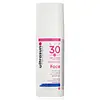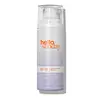What's inside
What's inside
 Key Ingredients
Key Ingredients

 Benefits
Benefits

 Concerns
Concerns

 Ingredients Side-by-side
Ingredients Side-by-side

Water
Skin ConditioningCaprylic/Capric Triglyceride
MaskingPentylene Glycol
Skin ConditioningMethylene Bis-Benzotriazolyl Tetramethylbutylphenol
UV FilterTitanium Dioxide
Cosmetic ColorantEthylhexyl Salicylate
UV AbsorberGlycerin
HumectantBis-Ethylhexyloxyphenol Methoxyphenyl Triazine
Skin ConditioningC12-15 Alkyl Benzoate
AntimicrobialDiethylamino Hydroxybenzoyl Hexyl Benzoate
UV FilterEthylhexyl Triazone
UV AbsorberC8-22 Alkyl Acrylates/Methacrylic Acid Crosspolymer
Polyacrylate Crosspolymer-6
Emulsion StabilisingSqualane
EmollientEctoin
Skin ConditioningCocoglycerides
EmollientHydrogenated Phosphatidylcholine
EmulsifyingVitis Vinifera Seed Extract
AntimicrobialDecyl Glucoside
CleansingSilica
AbrasivePropyl Alcohol
SolventAlcohol
AntimicrobialCetyl Phosphate
EmulsifyingXanthan Gum
EmulsifyingPropylene Glycol
HumectantT-Butyl Alcohol
PerfumingLecithin
EmollientTocopheryl Acetate
AntioxidantAscorbyl Tetraisopalmitate
AntioxidantTocopherol
AntioxidantDiisopropyl Adipate
EmollientUbiquinone
AntioxidantWater, Caprylic/Capric Triglyceride, Pentylene Glycol, Methylene Bis-Benzotriazolyl Tetramethylbutylphenol, Titanium Dioxide, Ethylhexyl Salicylate, Glycerin, Bis-Ethylhexyloxyphenol Methoxyphenyl Triazine, C12-15 Alkyl Benzoate, Diethylamino Hydroxybenzoyl Hexyl Benzoate, Ethylhexyl Triazone, C8-22 Alkyl Acrylates/Methacrylic Acid Crosspolymer, Polyacrylate Crosspolymer-6, Squalane, Ectoin, Cocoglycerides, Hydrogenated Phosphatidylcholine, Vitis Vinifera Seed Extract, Decyl Glucoside, Silica, Propyl Alcohol, Alcohol, Cetyl Phosphate, Xanthan Gum, Propylene Glycol, T-Butyl Alcohol, Lecithin, Tocopheryl Acetate, Ascorbyl Tetraisopalmitate, Tocopherol, Diisopropyl Adipate, Ubiquinone
Water
Skin ConditioningC12-15 Alkyl Benzoate
AntimicrobialCoco-Caprylate/Caprate
EmollientOctocrylene
UV AbsorberDicaprylyl Carbonate
EmollientDicaprylyl Ether
EmollientButyl Methoxydibenzoylmethane
UV AbsorberBis-Ethylhexyloxyphenol Methoxyphenyl Triazine
Skin ConditioningEthylhexyl Triazone
UV AbsorberPhenylbenzimidazole Sulfonic Acid
UV AbsorberTrimethoxybenzylidene Pentanedione
AntioxidantVp/Acrylates/Lauryl Methacrylate Copolymer
Sodium Hydroxide
BufferingPhenoxyethanol
PreservativeCarnosine
Skin ConditioningTetrasodium Glutamate Diacetate
Ethylhexyl Palmitate
EmollientCaprylyl Glycol
EmollientTocopherol
AntioxidantSilica Dimethyl Silylate
EmollientButylene Glycol
HumectantPentylene Glycol
Skin ConditioningSodium Hyaluronate
HumectantWater, C12-15 Alkyl Benzoate, Coco-Caprylate/Caprate, Octocrylene, Dicaprylyl Carbonate, Dicaprylyl Ether, Butyl Methoxydibenzoylmethane, Bis-Ethylhexyloxyphenol Methoxyphenyl Triazine, Ethylhexyl Triazone, Phenylbenzimidazole Sulfonic Acid, Trimethoxybenzylidene Pentanedione, Vp/Acrylates/Lauryl Methacrylate Copolymer, Sodium Hydroxide, Phenoxyethanol, Carnosine, Tetrasodium Glutamate Diacetate, Ethylhexyl Palmitate, Caprylyl Glycol, Tocopherol, Silica Dimethyl Silylate, Butylene Glycol, Pentylene Glycol, Sodium Hyaluronate
Ingredients Explained
These ingredients are found in both products.
Ingredients higher up in an ingredient list are typically present in a larger amount.
You might know this ingredient as Tinosorb S or Bemotrizinol. It is a UV filter that covers both UVA and UVB rays.
This ingredient has two peak UV absorption peaks ( 310 and 340 nm) and is able to absorb both UV-A and UV-B rays. This ingredient works by preventing UV rays from reaching and damaging your skin.
On top of that - it is highly photostable and helps prevent the photodegration of other sunscreen ingredients such as avobenzone.
Tinosorb S is allowed in the EU, Australia, and Asia. It is close to being approved by the FDA and we'll hopefully get this ingredient in the U.S. by late 2025.
Fun fact: Tinosorb S is the most effective UV absorber at maximum concentration (measured by SPF) permitted in the EU.
This ingredient is oil-soluble, so your oil-cleansers will take this right off at night.
Learn more about Bis-Ethylhexyloxyphenol Methoxyphenyl TriazineC12-15 Alkyl Benzoate is made up of Benzoic Acid and long chain alcohols. It has a low molecular weight.
C12-15 Alkyl Benzoate is an emollient and texture enhancer. Due to its solubility, it is often used in sunscreens to help evenly distribute active ingredients.
As an emollient, C12-15 Alkyl Benzoate helps soften and hydrate your skin. Emollients create a film on your skin that traps moisture within.
This ingredient has been reported to cause eye irritation.
Learn more about C12-15 Alkyl BenzoateEthylhexyl Triazone is a modern chemical sunscreen that protects from UV-B radiation.
It is the most effective of existing UV-B filters, as it provides the highest level of photo-stable absorption. It protects from the entire UV-B range (280 to 320nm), with it's highest level of protection at 314nm.
Ethylhexyl Triazone is oil soluble, oderless and colorless, which mean it is able to be incorporated into a variety of different formulations.
It is not currently available within the United States due to slow changing FDA regulations. Outside of the US, it is used in formulations at concentrations up to 5%.
Learn more about Ethylhexyl TriazonePentylene glycol is typically used within a product to thicken it. It also adds a smooth, soft, and moisturizing feel to the product. It is naturally found in plants such as sugar beets.
The hydrophilic trait of Pentylene Glycol makes it a humectant. As a humectant, Pentylene Glycol helps draw moisture from the air to your skin. This can help keep your skin hydrated.
This property also makes Pentylene Glycol a great texture enhancer. It can also help thicken or stabilize a product.
Pentylene Glycol also acts as a mild preservative and helps to keep a product microbe-free.
Some people may experience mild eye and skin irritation from Pentylene Glycol. We always recommend speaking with a professional about using this ingredient in your routine.
Pentylene Glycol has a low molecular weight and is part of the 1,2-glycol family.
Learn more about Pentylene GlycolTocopherol (also known as Vitamin E) is a common antioxidant used to help protect the skin from free-radicals and strengthen the skin barrier. It's also fat soluble - this means our skin is great at absorbing it.
Vitamin E also helps keep your natural skin lipids healthy. Your lipid skin barrier naturally consists of lipids, ceramides, and fatty acids. Vitamin E offers extra protection for your skin’s lipid barrier, keeping your skin healthy and nourished.
Another benefit is a bit of UV protection. Vitamin E helps reduce the damage caused by UVB rays. (It should not replace your sunscreen). Combining it with Vitamin C can decrease sunburned cells and hyperpigmentation after UV exposure.
You might have noticed Vitamin E + C often paired together. This is because it is great at stabilizing Vitamin C. Using the two together helps increase the effectiveness of both ingredients.
There are often claims that Vitamin E can reduce/prevent scarring, but these claims haven't been confirmed by scientific research.
Learn more about TocopherolWater. It's the most common cosmetic ingredient of all. You'll usually see it at the top of ingredient lists, meaning that it makes up the largest part of the product.
So why is it so popular? Water most often acts as a solvent - this means that it helps dissolve other ingredients into the formulation.
You'll also recognize water as that liquid we all need to stay alive. If you see this, drink a glass of water. Stay hydrated!
Learn more about Water